Construction and Long Term Storm water Management - Photo Essay
This photo essay was designed to show some methods used to control erosion before, during and after construction and to review some long term storm water management methods installed prior to your business operations. Once you have completed reviewing this page, hit your browser's "back" button to return to the storm water small business pages.
NOTE: Two Technical Guidance Documents that will help
Before reading the following photo essay, note that The Wisconsin Department of Natural Resources and University of Wisconsin Extension have each published a technical guidance document to assist you in creating your plan.
Construction Storm water Management (Erosion Control)
When beginning to locate your small business on a new property, it is
important to design your site with erosion control and construction storm
water management practices in mind. Minimizing 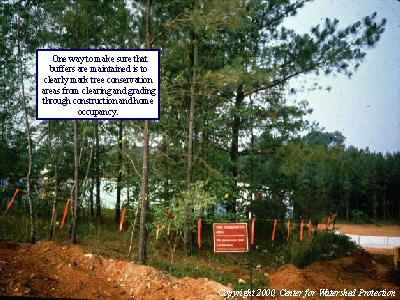 land
disturbance and keeping native vegetation and soils in place will have
the greatest long term impact on protecting the watershed and any nearby
water bodies (lakes, rivers and wetland areas) where runoff ultimately
travels to. This up-front planning will save dollars otherwise earmarked
for storm sewer fees, lawn creation and maintenance costs, and disposal
charges, to name a few.
land
disturbance and keeping native vegetation and soils in place will have
the greatest long term impact on protecting the watershed and any nearby
water bodies (lakes, rivers and wetland areas) where runoff ultimately
travels to. This up-front planning will save dollars otherwise earmarked
for storm sewer fees, lawn creation and maintenance costs, and disposal
charges, to name a few.
An excellent resource published by UW Extension is Preserving Trees During Construction - pdf (EXIT DNR) (222 K).
But some land disturbance will ultimately occur due to building footprint needs, parking areas, driveways, etc. Since a construction and long term storm water management plan is required prior to any construction activities, please read through the following key points to assist you in creating and implementing sound erosion control and flow management plans for your small business site.
Site Phasing
When first creating your erosion control plan, try to design site phasing into the construction. Site phasing minimizes soil erosion by having smaller portions of your site disturbed at any one time (e.g. fitting the development to the topographic "lay of the land", minimizing the development footprint by clearing only the land required for buildings, roads, and utilities, and providing buffers from natural drainage systems and water bodies).
For more information on site phasing, please refer to the following article: "Practical Tips for Construction Site Phasing (EXIT DNR)"- (PDF, (680 KB) Published by the Center for Watershed Protection
Sediment ControlsSediment control practices are designed to remove some of the soil particles that are suspended in runoff. By using properly installed silt fencing, straw bales, sediment traps or sediment basins, any sediment or other materials will be held in place on the construction site and not end up in wetlands, lakes, or rivers. These should be written into the erosion control plan and installed within 24 hours of any land disturbance. Silt fencing, if installed improperly, can cause a greater release during a major rainfall event. |
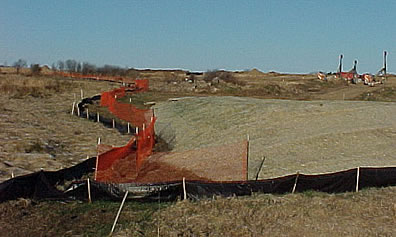 |
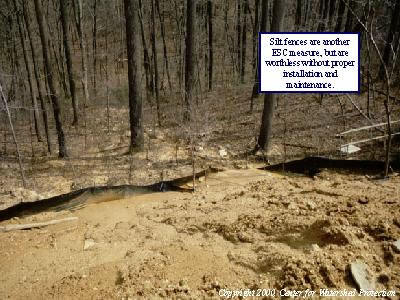 |
Photos used with permission from the Center for Watershed Protection. A good source of information on proper instrallation of straw bales and silt fences is the UW Extension publication "Erosion Control for Home Builders" - pdf (EXIT DNR). This document covers the more common erosion control practices used during development of a site. |
Erosion Controls
 Mulches,
blankets and matting, seeding and soil stabilizers are used to stabilize
a recently disturbed area and minimize the dislodging of soil particles
by raindrop impacts and flowing water. Someadvantages include: reducing
flow velocities of storm water through the area and reducing moisture
loss when seeding and planting is done. They prevent crusting and sealing
of the soil surface and moderate soil temperatures. This allows seed germination
to occur more readily. And they increase infiltration of storm water at
the site.
Mulches,
blankets and matting, seeding and soil stabilizers are used to stabilize
a recently disturbed area and minimize the dislodging of soil particles
by raindrop impacts and flowing water. Someadvantages include: reducing
flow velocities of storm water through the area and reducing moisture
loss when seeding and planting is done. They prevent crusting and sealing
of the soil surface and moderate soil temperatures. This allows seed germination
to occur more readily. And they increase infiltration of storm water at
the site.
Mulching: A protective blanket of straw or other plant residue, gravel, or synthetic material applied to the soil surface to minimize raindrop impact energy and runoff, foster vegetative growth, reduce evaporation, insulate the soil, and suppress weed growth. Mulch provides immediate protection, and straw mulch is also typically used as a matrix for spreading plant seed. Organic mulches such as straw, wood chips, and shredded bark have been found to be the most effective. Straw typically requires some kind of tacking, such as liquid emulsions or netting. Netting may also be needed to hold mulch in place on slopes.
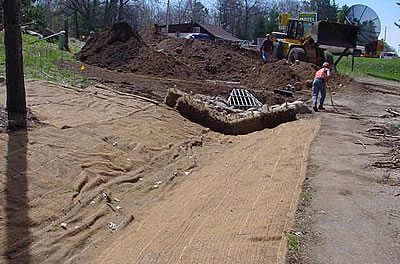 Mats
and blankets are made from a wide variety of organic and synthetic materials
and are useful in establishing grass in swales and waterways, plus they
promote seedling growth.
Mats
and blankets are made from a wide variety of organic and synthetic materials
and are useful in establishing grass in swales and waterways, plus they
promote seedling growth.
Erosion Control Products Availability List
Erosion Control Product Availability Lists (PAL) - Wisconsin DOT (Exit DNR)
The above list was compiled by the Wisconsin Department of Transportation to highlight advances in erosion mats, soil stabilizers, tackifiers and silt fences.
Long Term Storm water Management Plan (Flow Management)
Planning for long term collection and treatment of storm water runoff early in your site planning process will save dollars and protect nearby waterways. When writing the long term storm water management portion of your plan, include the following commonly used practices. These practices, when used solely, or in combination, will hold back sediment while allowing runoff water to seep slowly back into the ground.
Wet Detention Basins
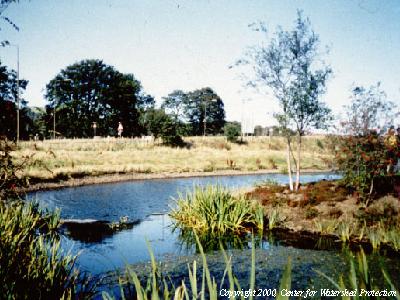
A permanent pool of water with designed dimensions, inlets, outlets and storage capacity, constructed to collect, detain, treat and release stormwater runoff. The wet detention basin is the most common long-term stormwater management practice used in Wisconsin.
Infiltation Basins and Trenches
Infiltration basins and trenches are used to hold sediment in place, preventing it from choking out and making wetlands ineffective or adding to silty deposits in nearby rivers and lakes. These basins can be very important during larger storms when other storm water management practices cannot treat or recharge runoff as well.
Grassed Swales
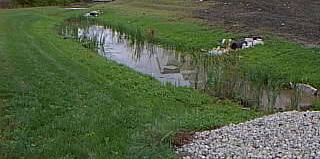 Grassed
swales function by slowing runoff as it comes off an impervious surface
(such as the principal parking area for your business). The grassed swale
can remove sediments and other pollutants and provides some infiltration
into the soil. A drawback, however, is that they can be ineffective at
treating and absorbing runoff during a larger rain event.
Grassed
swales function by slowing runoff as it comes off an impervious surface
(such as the principal parking area for your business). The grassed swale
can remove sediments and other pollutants and provides some infiltration
into the soil. A drawback, however, is that they can be ineffective at
treating and absorbing runoff during a larger rain event.
Storm water Wetlands (a.k.a constructed wetlands, artificial wetlands)
 Storm
water wetlands are shallow pools that have wetland plants which remove
pollutants through biological uptake. They are among the most beneficial
in removing pollutants and are aesthetically pleasing, as well. Storm
water wetlands can provide educational and habitat benefits and can be
incorporated into any existing ponds or swales you may already have in
place.
Storm
water wetlands are shallow pools that have wetland plants which remove
pollutants through biological uptake. They are among the most beneficial
in removing pollutants and are aesthetically pleasing, as well. Storm
water wetlands can provide educational and habitat benefits and can be
incorporated into any existing ponds or swales you may already have in
place.
Parking Lots - Pavers, Porous Concrete and Bioretention Islands
 Can
your small business design a better parking lot? According to Watershed
Protection Techniques [3(2): 647] "parking lots rank among the most
harmful land uses in any watershed. They not only collect pollutants that
are deposited from the atmosphere, but also accumulate pollutants that
leak, drip or wear off cars."
Can
your small business design a better parking lot? According to Watershed
Protection Techniques [3(2): 647] "parking lots rank among the most
harmful land uses in any watershed. They not only collect pollutants that
are deposited from the atmosphere, but also accumulate pollutants that
leak, drip or wear off cars."
The article also mentions several design ideas such as reducing stall sizes, narrowing drive aisles and using inovative materials and practices such as grid pavers, porous concrete and bioretention islands (photos below) to absorb storm water.
For more information on better site design oprtions, please refer to the following article: "The Benefits of Better Site Design in Commercial Development"- (PDF, 680 KB) (EXIT DNR) Published by the Center for Watershed Protection

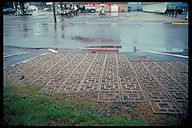
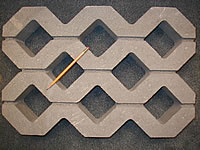
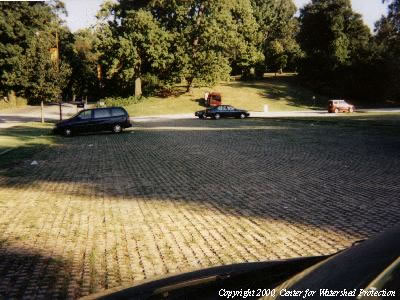

The above two photos used with permission from the Center for Watershed Protection.
There are several other long term flow management practices that can be incorporated into your site design to minimize your impact to the local watershed and save you money. Please refer to the "Related Links" (button found along the left margin of most pages within the Small Business Web Site) topic when you have completed the other topics.


